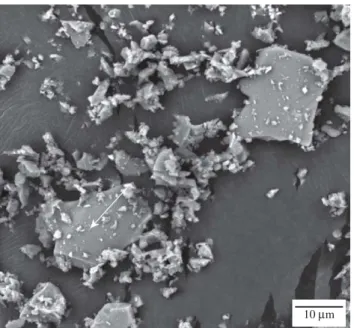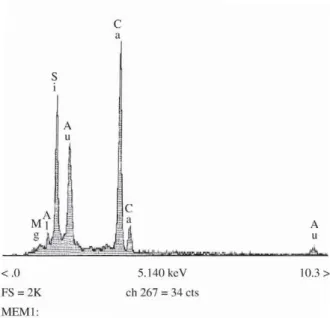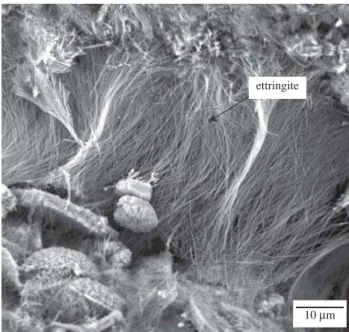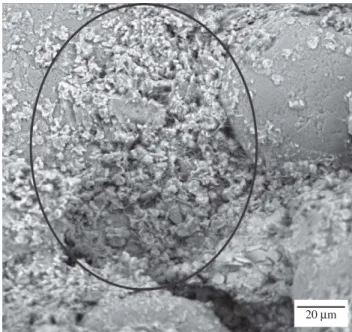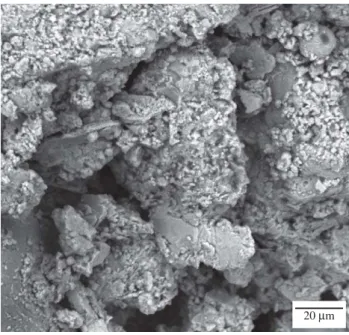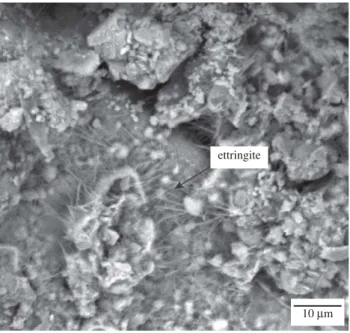*e-mail: gemelli@joinville.udesc.br
A Study of the Application of Residue from Burned Biomass in Mortars
Enori Gemelli*, Arthur Adelino de Freitas Cruz, Nelson Heriberto Almeida Camargo
Department of Mechanical Engineering, Center of Technological Sciences, UDESC Santa Catarina State University, Bom Retiro, 89223-100 Joinville - SC, Brazil
Received: October 7, 2003; Revised: June 30, 2004
The goal of this work was to study the viability of burnt biomass residue from a pulp and paper plant applied as a raw material for mortar used in the construction industry. The waste – bottom ash – was incorporated into the mortar as a mineral addition to the Portland cement. The effect of the waste’s grain size on the properties of mortars containing 10% in volume of waste was investigated, as well as the effect of the concentration of waste with grain size under 0.15 mm. The samples were evaluated after 28 days of aging by uniaxial compression, leaching test and scanning electron microscopy. These characterization techniques indicated that the properties of the mortars depend on the concentration, granulation and size distribution of the waste in the mortar’s structure. Furthermore, some chemical elements may be present in stabilized and/or en-capsulated form in the cement matrix.
Keywords:waste, mortar, construction materials
1. Introduction
In the last two decades, the Brazilian NBR 10004 code has forced factories to adopt suitable treatment and disposal procedures for their industrial wastes. Since then, indus-trial wastes have become a major concern, involving legal environmental responsibility and final disposal costs. In an effort to minimize these costs, many studies have concen-trated on assessing the utilization of certain wastes as raw materials in the construction industry1-5. Depending upon
their chemical composition, these wastes can be incorpo-rated into mortars to partially replace cement and/or aggre-gate. In a recent study5, we investigated the performance of
mortars produced with wastes from industrial pulp and pa-per processes. Four types of residue, namely fibers, dregs, bottom ash and grit, were selected and studied. Bottom ash and dregs were used to partially replace Portland cement, and fiber and grit were used to partially replace aggregate. Our conclusion regarding these wastes, as raw materials for mortars were that bottom ash stands out from the other types of residue as a mineral addition to the Portland cement. Ac-tually, utilization of bottom ash in public constructions is encouraged in other countries6,7. Usually, mechanical
strength and environmental impact are evaluated on these materials. Mechanical strength is directly related with the defects in mortar microstructure1,2,4,5. These defects are
broadly evaluated by microscopic analyses, mainly by
scan-ning electron microscopy, which provides important data on mortar studies. On the other hand, the major concern regarding the utilization of these materials is the environ-mental impact they can cause6-10. Experiments carried out
during three years on road constructions under real condi-tions7, have shown a low contribution of bottom ash on the
composition of the percolation water. Nevertheless, the uti-lization of bottom ash as raw material depends on the regu-lations of each country. Therefore, this work proposed to make a more in-depth investigation of the effect of bottom ash on the properties of mortars, evaluating the effect of the concentration and size granulation of this residue on the mechanical, microstructural and environmental impact.
2. Materials and Experimental Procedure
purities.
2.1. CPV ARI portland cement
The CPV ARI Portland cement, which was supplied by Companhia de Cimento Itambé, has a density of 3,12 g/cm3
and high strength at early ages – about 27 MPa after one day, i.e. about 50% of its final strength obtained after 28 days – as well as good resistance to sulphate environments. Ta-ble 1 lists the chemical composition of CPV ARI Portland cement. This composition is equivalent to the oxide com-position of the basic compounds of Portland cement after calcination, which are mainly 3CaO.SiO2, 2CaO.SiO2, 3CaO.Al2O3 and 4CaO.Al2O3.Fe2O3.
2.2. Solid bottom ash waste
Solid bottom ash is a residue of burnt eucalyptus and pine, which are used to produce thermal energy. This resi-due, composed of hard agglomerates of 1 to 3 cm, was ground to produce raw material, using water and a lain ball mill at 50 rpm for 12 h. The proportion of porce-lain balls and waste was 2:1 by mass. After grinding, the sludge was dried for 4 h in a rotary evaporator at 70 °C (silicone oil temperature) at 8 rpm. Table 2 lists the charac-teristics of solid bottom ash waste.
The powder thus obtained was sieved through the fol-lowing mesh sizes, according to the NBR 7217 code: 20, 30, 40, 50, 70, 100, 140, 200 and 270-mesh. The operation was performed in a mechanical shaker for 15 min, using 50 g of residue. The mass retained on each sieve was deter-mined by mass difference. Table 3 indicates the granulometric distribution of the residue used in this study. Table 3 indicates that 72.74% of the residue sifted through the 270-mesh sieve had a grain size of up to 0.053 mm and that 91.06% of the residue sifted through the 100-mesh sieve had a grain size of up to 0.150 mm, con-firming that the residue’s grain size was small after 12 h of grinding.
2.3. Aggregate
The aggregate used in this work originated from sedi-mentary layers formed in riverbeds near Joinville, state of Santa Catarina, Brazil, and was supplied by Mineração Veiga Ltda of Araquari, SC. This aggregate had a real density of about 1.5 g/cm3 and presented an AFS size module of 88.88
and 0.2% of clay. The granulometric distribution of the ag-gregate (sand) is presented in Table 4.
2.4. Production of mortars
The bottom ash was incorporated into the mortars as a mineral addition to the Portland cement. The samples were prepared in two steps. In the first, samples were prepared containing 90% of cement plus 10% by volume of bottom
Table 3. Granulometric distribution of the bottom ash waste after grinding in agreement with NBR 77211 code.
Sieve mesh Sieve mesh Mass retained size (mm) on the sieve (%)
Amount Total
per sieve amount
20 0.850 0.98 0.98
30 0.590 1.54 2.52
40 0.420 1.32 3.84
50 0.290 1.58 5.42
70 0.240 2.00 7.42
100 0.150 1.52 8.94
140 0.106 2.40 11.34
200 0.075 7.20 18.54
270 0.053 8.72 27.26
Bottom dish 72.74 100.00
Table 2. Characteristics of solid bottom ash waste.
Humidity (H2O) 7.0% (by mass)
pH 10.21
Real density 2.70 g/cm3
C 4.0%
P 4270.0 ppm
SiO2 1.66 %
N 800.0 mg/l
K 29870.0 ppm
Na 46000.0 ppm
S 2.4 mg/l
CaO 36.4%
MgO 1.43%
Inert ash 47.54%
Table 1. Chemical composition of CPV ARI Portland cement (CIA de Cimento Itambé).
Compound Mass (%)
SO3 2.98
Free CaO 1.59
MgO 2.91
Al2O3 4.44
SiO2 19.49
Fe2O3 2.86
CaO 62.52
Na2O and K2O 0.56
Residue 0.66
be-tween 0.30 and 0.57 mm, bebe-tween 0.15 and 0.30 mm and under 0.15 mm. The second step consisted of studying the effect of the concentration of residue having a grain size of less than 0.15 mm. Samples were prepared with cement plus 5, 10, 15 and 20% by volume of waste. The raw materials used to produce the mortars were oven-dried and then mixed in a mass proportion of three parts of sand (aggregate) for one of cement plus bottom ash. The mortars were produced according to the Brazilian NBR 12821 code. Table 5 lists the mixtures used in the preparation of the mortars. The samples were casted in three mortar layers into 50 mm di-ameter and 100 mm longmolds. Each layer was compacted using 20 strokes of a standard rod. The samples were re-moved from the molds after 24 h and then they were cured in alkaline water for 28 days. For each formulation was pro-duced 10 samples. Upon completion of the curing process, the samples were subjected to mechanical axial compres-siontests. The samples were coated with sulfur to render them flat and smooth surfaces for better contact with the mechanical compression devices. The microstructural char-acterization, performed by scanning electron microscopy (SEM), were carried on the samples fragments, obtained from the mechanical test. Before the observation, the frag-ments were dried in a drying-room during 24 h at 100 °C. The fragments were fasten on a sample rack with carbon glue and metallized with a 12 nm gold layer.
3. Experimental Results
3.1. Axial compression strength of the samples containing 10% of bottom ash with different grain sizes
The test was performed at a speed of 1 mm/min in a mechanical testing machine. Figure 1 illustrates the aver-age rupture stress of the mortars.
It can be seen in Fig. 1, the mechanical strength of the mortar tended to decrease as the residue’s grain size in-creased. The residue caused a slight decrease of approxi-mately 8.5% in the mechanical strength of the samples with waste grain sizes of up to 0.15 mm. A significant drop in the average mechanical strength was observed when resi-due grain sizes of 0.15 to 0.30 mm were used. Afterward, the mechanical strength tends to decline slowly and steady as the grain sizes increase.
3.2. Axial compression strength of samples with grain size up to 0.15 mm in different concentrations
The effect of the concentration of residue with a grain size of up to 0.15 mm incorporated into the mortars is pre-sented in Fig. 2. The mechanical strength decreased slightly and linearly with increasing amounts of residue, correspond-ing to a reduction of about 3.85% for each addition of 5% of bottom ash. These results led to the conclusion that it is more advantageous to produce mortars containing 20% of residue with grain sizes of up to 0.15 mm than with 10% of residue with grain sizes above 0.15 mm.
3.3. Microstructural and morphological analyses of raw materials
Bottom ash waste. The bottom ash powder was found to have a variety of particle shapes and sizes, as illustrated in Fig. 3. Calcium, silicium, aluminum and potassium were detected through chemical analyses performed by energy dispersive spectroscopy (EDS) (see Fig. 4). These analyses showed that the residue was composed mainly of silicium and calcium-containing compounds. The high amount of silicium indicated that the inert bottom ash listed in Table 2 consisted essentially of silica.
Aggregate. SEM observations of the aggregate to as-sess its quality revealed that it contained a very small amount of impurities, according to the supplier’s specifications (Fig. 5). This finding is corroborated in Fig. 6, which shows the EDS analyses, indicating a very small amount of aluminum and confirming that the aggregate consisted ba-sically of silica and traces of clay. Figure 5 also shows that
Table 5. Amount of materials used to produce 10 samples for each formulation.
Bottom ash (% by volume) Aggregate (g) Cement (g) Bottom ash (g) Water/cement ratio
0.0 3744 1248.0 0 0.48
5.0 3744 1185.6 54 0.48
10.0 3744 1123.2 108 0.49
15.0 3744 1060.8 162 0.49
20.0 3744 998.4 216 0.49
Table 4. Granulometric distribution of the aggregate in agreement with NBR 77211 code.
Sieve mesh Sieve mesh Mass retained size (mm) on the sieve (%)
Amount Total
per sieve amount
10 2.000 0.05 0.05
20 0.850 0.17 0.22
30 0.590 8.58 8.80
40 0.420 29.84 38.64
the average grain size of 0.11 to 0.15 mm met the specifica-tions of the AFS 80 to 90 standards for aggregates.
CPV ARI cement. This cement presented different par-ticle shapes and sizes (Fig. 7) similar to those of bottom ash. Silica and calcium crystals, as well as spherical-shaped pozzolan, are clearly visible in Fig. 7. As illustrated in Fig. 8, the chemical composition of cement particles consists of Ca, Si, Al and Mg, which are the main chemical elements in cement compounds.
3.4. Microstructural and morphological characterization of mortars
Mortar without bottom ash. The samples were char-acterized on the fracture cross-section, where good adher-ence of the gel (cement paste) on the aggregate (Fig. 9) and low porosity was observed. Figure 10 illustrates the good nucleation and growth of ettringite, revealing a normal hy-dration process during the 28-day curing period. The ettringite crystals are also known as anhydrite crystals and are formed by precipitation of aqueous ions of aluminum, sulfur, and calcium, known as hydrated calcium aluminum sulfate hydroxide.
Mortar with 10% of bottom ash and different grain sizes. Mortars with grain sizes of 1 to 2 mm and 0.59 to 1 mm displayed sites containing larger concentrations of bottom ash, as indicated in Figs. 11 to 14. These figures show that bottom ash grains disintegrate readily in mortar during its manufacturing process or when the material is subjected to compressive forces. This is possible because the residue grain is formed by an agglomerate of its parti-cles. Furthermore, sites containing high concentrations of residue impede the nucleation of ettringite.
Figure 1. Effect of residue grain size on the mortars’ axial me-chanical strength.
Figure 3. SEM micrograph showing a variety of particle shapes and sizes. The arrow on this figure shows the place where EDS spectrum was performed.
Figure 4. EDS spectrum showing the residue’s main chemical el-ements. The gold (Au) on the spectrum is coming from the prepa-ration of the sample (metallization).
Figure 2. Effect of the concentration of waste with grain sizes of less than 0.15 mm on the mortars’ axial mechanical strength.
As illustrated in Figs. 15, 16, 17 and 18, the grain sizes of 0.30 to 0.59 mm and 0.15 to 0.30 mm displayed better homogenization of the bottom ash in the mortar than did the grain sizes of 1 to 2 mm and 0.59 to 1 mm. Ettringite crystals were found to germinate and grow in preferential regions, as indicated in Fig. 16, possibly due to larger
amounts of water dissolved in these regions of the mortar (better conditions of hydration) and/or larger concentrations of calcium oxide.
Figures 19 and 20 depict test specimens containing bot-tom ash with a grain size of under 0.15 mm. This grain size promoted a better formation of ettringite crystals than the
Figure 5. SEM micrograph of the aggregate’s morphology. The arrow on this figure shows the place where EDS spectrum was performed.
Figure 6. EDS analysis showing traces of clay in the aggregate. The gold (Au) on the spectrum is coming from the preparation of the sample (metallization).
Figure 7. SEM micrograph showing varied cement particle sizes as received (unreacted cement). The arrow on this figure shows the place where EDS spectrum was performed.
Figure 8. EDS image of the main chemical composition of the cement. The gold (Au) on the spectrum is coming from the prepa-ration of the sample (metallization).
other grain sizes studied. Among the samples containing residue, this grain size offered the more homogeneous gel/aggregate interface.
Mortars containing different concentrations of resi-due with grain sizes under 0.15 mm. The mortar contain-ing 5% of residue displayed a good gel/aggregate interface
compared with the sample containing the same residue grain size but a higher concentration of bottom ash. Figures 21 and 22 reveal the growth of ettringite crystals and lower porosity. The samples containing 15 and 20% of residue, Figs. 23, 24, 25 and 26, showed a more homogeneous distribution of the residue than the samples with grain size over 0.15 mm.
Figure 9. SEM micrograph of the mortar’s gel/aggregate interface without residue.
Figure 11. SEM micrograph of disintegrated residue in the mortar containing bottom ash with 0.59 to 1 mm grain sizes.
Figure 12. Micrograph of the mortar containing residue with grain sizes of 1 to 2 mm, showing ettringite crystals.
Figure 10. SEM micrograph of ettringite crystals in the mortar without residue.
ettringite
5 µm 10 µm
ettringite
These samples also showed a slight increase in porosity and greater inhibition of ettringite crystal growth than in the sam-ples containing lower concentrations of residue.
3.5. Leaching tests
Leaching tests were carried out following the Brazilian
NBR 10004 code. Complementary solubilization tests were not performed because our purpose was not to classify the materials but to ascertain, in the first phase, if certain chemi-cal elements of the residue can be retained in the cement paste. The chemical elements chosen for leaching tests were those that represent the highest risk to fauna and flora. These
Figure 13. Micrograph of the mortar containing residue with grain sizes of 0.59 to 1 mm, revealing bottom ash agglomerated in local-ized sites.
Figure 14. Micrograph of the mortar containing residue with grain sizes of 0.59 to 1 mm, showing ettringite crystals in the regions close to the bottom ash agglomerates.
Figure 15. Micrograph of the mortar containing residue with grain sizes of 0.30 to 0.59 mm, showing a more homogeneous distribu-tion of the bottom ash.
Figure 16. Micrograph of the mortar-containing residue with grain sizes of 0.30 to 0.59 mm, highlighting the ettringite crystals.
10 µm ettringite
5 µm
ettringite
are, in general, chemical elements responsible for classify-ing the residue as Class II waste.
Table 6 shows the chemical analyses of the leached ma-terial. It was found that, in every sample, the chemical ele-ments analyzed all displayed concentrations below the maxi-mum limits established by the NBR 10004 code. An
analy-sis of the results indicated that the chemical elements from the leached extracts of mortar without residue and with 20% of residue showed similar concentrations. A rough estimate indicates that, if the 20% of residue incorporated into the mortar in place of cement displayed leaching proportional to the samples containing 100% of bottom ash, the values
Figure 17. Micrograph of the mortar-containing residue with grain sizes of 0.15 to 0.30 mm showing the cement gel.
Figure 18. Micrograph of the mortar-containing residue with grain sizes of 0.15 to 0.30 mm, highlighting the irregular growth of the ettringite crystals.
Figure 19. Micrograph of the mortar containing residue with a grain size of less than 0.15 mm, highlighting the ettringite crys-tals.
Figure 20. Micrograph of the mortar-containing residue with a grain size of less than 0.15 mm, revealing the presence of bottom ash.
5 µm ettringite
50 µm ettringite
20 µm
found for the mortar containing 20% of residue should gen-erally be greater than those of the mortar without residue. This led to the conclusion that the majority of the chemical elements analyzed were practically stabilized and/or encap-sulated within the cement paste. However, to reach a more conclusive result, further analyses are required, especially
solubilization tests, including all the chemical elements es-tablished by international standards.
4. Discussion of the Results
The raw materials used in this investigation possess some specific known characteristics, which were validated before
Figure 21. Micrograph of the mortar containing 5% of residue with grain size under 0.15 mm, highlighting good gel/aggregate interaction.
Figure 22. Micrograph of the mortar containing 5% of residue with grain size under 0.15 mm, showing the ettringite crystals.
Figure 23. Micrograph of the mortar containing 15% of residue with grain size under 0.15 mm, illustrating the distribution of the residue.
Figure 24. Micrograph of the mortar containing 15% of residue with grain size under 0.15 mm (greater magnification).
50 µm
ettringite
50 µm
the mortars were prepared. The sand was found to be of good quality, showing a low concentration of impurities and grains with an irregular geometry. This characteristic of the sand grains may reduce the workability of the mortar but, on the other hand, enables the cement paste to adhere more easily on the surface of the sand grains. The EDS analysis also revealed that the two main oxides of bottom ash, i.e., calcium oxide and silicon oxide, are also the two main com-ponents of cement, indicating that bottom ash has a certain chemical affinity with cement. This chemical similarity is clearly visible through a comparison of the chemical analy-ses of the residue and the cement (Tables 1 and 2).
Magne-sium oxide is another chemical compound present in the two materials; however, the bottom ash showed a high con-centration of “inert ash” (approximately 47%) and a small concentration of sulfur. The Brazilian NBR 10004 code clas-sifies bottom ash as non-inert, which means that at least some of the components of bottom ash may react and/or hydrate during hydration of the cement paste. Although this could reinforce the idea of using this residue as a partial substitute for cement, it should be noted that a large amount of suppos-edly inert bottom ash present in the residue may inhibit or counterbalance the possible positive effect of certain elements of the residue, and may even lead to an overall negative
ef-Table 6. Chemical analysis of the leached extracts.
Element Bottom Ash Mortar with 20% Mortar without Maximum Limit
(mg/l) of bottom ash (mg/l) residue (mg/l) NBR 10004 (mg/l)
Chromium Not detected 0.0874 0.162 5.0
Arseno group 0.00803 0.00082 0.00062 5.0
Lead 0.00120 0.00083 0.00072 5.0
Selenium Not detected Not detected 0.00145 1.0
Silver 0.00074 0.000384 0.00028 5.0
Cadmium 0.000198 0.000366 0.00043 0.5
Barium 0.392 0.634 0.660 100.0
Mercury 0.00158 0.00074 0.00040 0.1
Chlorides 0.0000178 0.00000890 0.00000890
-Fluorides 0.00000026 0.00000165 0.00000158 150.0
Figure 26. Micrograph of the mortar containing 20% of residue with grain size under 0.15 mm, depicting the ettringite crystals.
Figure 25. Micrograph of the mortar containing 20% of residue with grain size under 0.15 mm, showing a greater concentration of bottom ash.
10 µm ettringite
fect on the hydration process of the binder. Therefore, it is impossible to state unequivocally that the reduction in me-chanical strength of the samples containing residue was also due to the reduction in the amount of cement, since part of it was replaced by residue. Should such a statement be made, it would be based on the assumption that the residue does not positively affect the hydration process of the cement paste. On the other hand, it is possible to affirm that the mechanical strength depends on the distribution of the residue in the mortar. It was observed that the residue grains are visible as defects in the cement paste because they disintegrate easily under mechanical forces. The larger the grains the greater the defects and, hence, the lower the mechanical strength. This effect of the grains is illustrated in the graph showing the mechanical strength in Fig. 1. In contrast, Fig. 2 reveals greater mechanical strength even at higher concentrations of residue, but with smaller grain sizes than those of Fig. 1.
The metallographic analysis carried out by SEM revealed that, in the sites where the waste accumulated, the “inert ash” contained in the waste inhibited the formation and growth of ettringite crystals. The residue also contains sulfur, which may react with calcium to form ettringite crystals, but these chemical elements encounter unfavorable condi-tions when in contact with inert ash. The effect of inert ash on mechanical strength has already been demonstrated in earlier studies5, in which two commercial Portland cements
were used – CPII-Z-32 and CPI-S-32. The former, CPII-Z-32, containing a large amount of inert ash, showed low mechanical strength in the order of 5 MPa after 28 days of curing in a saturated medium. The mortar obtained with the same formulation, but with the CPI-S-32 cement, dis-played a much higher mechanical strength of around 21 MPa after 28 days of curing in a humid saturated medium. The latter mortar showed mechanical strength comparable to that of the mortar without residue produced in the present study (22 MPa). However, it must be kept in mind that the grain size of the sand used in the present study was smaller than that utilized by the above-cited authors and that this may have influenced the values of mechanical strength of the mortars/concretes. Certain cements are commercialized on a large scale, as in the case of the CPII-Z-32 cement. The “inert ash” found in this cement originates from incinera-tors or from thermoelectric plants, and is often used to re-duce the cost of cement6,7. Since the raw (unprocessed)
resi-due exists in the form of agglomerates of a few centimeters in size, we suggest to grind it together with the clay or lime-stone used in the production of cement in order to avoid processing it separately and then add it to the mortar, as done here. For the pulp and paper industry, it would be a great advantage, from the standpoint of cost and environ-mental responsibility for the residue, to have its waste used in the production of cement. The pulp and paper industry could supply the residue to the cement industry, totally
cost-free including transportation, since that would be cheaper than depositing it in an industrial landfill, as is the current practice. Moreover, when a residue is transformed into a raw material, the company generating the waste is exempt of environmental responsibility, provided the residue loses its characteristics. Coprocessing systems such as those em-ployed by cement manufacturers cause the residue to lose its characteristics, thus exempting the original generator of the waste (after the process is completed) from responsibil-ity for the processed product. Of course, the use of residue as a raw material depends on its behavior in relation to the environment. This evaluation is quite a complex one be-cause, on the one hand, the current code is limited to nam-ing and classifynam-ing industrial by-products as Class I, II or III residues, without evaluating the purposes and conditions of use of materials that could be produced with residues. On the other hand, there are many materials and raw mate-rials that, if assayed by leaching and solubilization tests, would be classified as residues. That is the case of some types of cement currently manufactured and commercial-ized. Therefore, it is difficult in this study to reach a conclu-sion about the commercial use of bottom ash based on leach-ing and solubilization tests. All that can be said is that the concentrations of chemical elements analyzed in the mor-tar with and without residue were very similar and lower than the maximum limit established by the Brazilian NBR 10004 code, and that is highly probable that at least certain chemical elements of the residue remain partially encapsu-lated, chemically or mechanically, within the cement paste. It is also worth pointing out that some European countries take a different approach to the question of wastes. In France, today, a federal law requires that companies reduce the quan-tity of wastes destined for industrial landfills. Certain in-dustrial wastes can no longer be deposited in such landfills and must be used as raw materials, mainly in public works, or for the generation of energy. Nowadays, the use of wastes in materials depends largely on cost. However, for sustain-able development, other parameters will have to be taken into consideration that undergo the creation of federal laws and a new concept and policy of utilization of materials.
5. Conclusions
10% of residue of different grain sizes showed a marked drop in mechanical resistance as the grain size of the resi-due increased. For resiresi-due grain sizes of less than 0.15 mm, the mechanical resistance was 20 MPa, very close to the mechanical strength of mortar without residue (22 MPa). With a grain size of 0.30 to 0.59 mm, the mechanical strength dropped to 13 MPa, and then to 9 MPa in the mortar con-taining residue grain sizes of 1 to 2 mm.
In the test specimens prepared with various concentra-tions of residue having grain sizes below 0.15 mm, the de-crease in mechanical strength was small and linear, i.e., around 0.16 MPa for every 1% of residue added to the mor-tar. Therefore, for 20% of residue, the decrease in average rupture stress was 3.21 MPa, i.e., from 22 MPa for the mor-tar without residue to 18.8 MPa for the mormor-tar containing 20% of residue. These findings indicate that it is more ad-vantageous to use 20% of residue with a grain size of less than 0.15 mm than any of the other grain sizes tested with 10% of residue in the mortar.
The microstructural analysis indicated that the mechani-cal resistance of the samples was dependent on the concen-tration of inert ash in the residue and on the distribution of the residue in the mortar. This finding is clearly visible in the samples containing larger residue grain sizes. The resi-due’s grains appear in the structure of the mortar as points of concentration of inert ash owing to the large quantity of this material in the residue. These points, or sites, of inert ash concentrations embrittle the mortar by inhibiting the formation and growth of ettringite crystals and by forming points of discontinuity in the cement paste (defects). The more homogeneous the residue’s distribution and the smaller its grain size, the lower the amount and size of the discontinuities in the cement paste (the fewer the number and size of defects) and also the less the interference of the residue in the process of hydration and crystallization of the compounds in the cement paste. The reduction in me-chanical strength may also have been partially due to the decrease in the amount of cement in the formulations con-taining residue.
With regard to the leaching tests, it was found that the concentration of the chemical elements analyzed in the leached extracts of the mortar containing 20% of residue and in the mortar without residue was very similar, and that
values. All the substances analyzed displayed concentra-tions below those of the maximum limit established by the Brazilian NBR 10004 code, and it is likely that many of the chemical elements possibly harmful to humans and to the environment become partially chemically stabilized (bonded) or solidified within the cement paste.
Lastly, it would be interesting to investigate the possi-bility of incorporating the residue in the cement manufac-ture. It would, in that case, be processed together with the clay or limestone used in the manufacture of cement. It would be a raw material supplied at no cost by the residue generating plant and could reduce the price of commercial cement, as in the case of the use of ash deriving from incin-erators or thermoelectric power plants. Therefore, the resi-due could be added to mortars or concretes indirectly through cement.
References
1. Masuero, A.B.; Dal Molin, D.C.C.; Vilela, A.F. Anais do 13º CBECIMAT, CDROM, p. 4769, 1988.
2. Moura, W.A.; Dal Molin, D.C.C.; Vilela, A.F. Anais do 13º CBECIMAT, CDROM, p. 3403, 1988.
3. Teles, A.R.; Camargo, N.H.A. Elaboração e Caracterização de Blocos para Construção Civil a Partir de Resíduos sólidos Industriais, Relatório de Iniciação Científica, CNPq, p. 51, 1999.
4. Watanabe, A.P.; Nunes, J.J.; Rebello, L.; Moreno, M.A.; Mendes, J.M.M.; Buchler, P.M. Anais do 38º Congresso Brasileiro de Cerâmica e 2º Encontro de Mineradores e Consumidores, v. 2, p. 546, 1994.
5. Gemelli, E.; Camargo, N.H.A.; Brescansin, J. Materials Research, v. 4, n. 4, p. 297, 2001.
6. Bruder-Hubscher, V.; Lagarde, F.; Maurice, L. Déchet: Sciences & Techniques, n. 18, p. 3, 2000.
7. Bruder-Hubscher, V.; Lagarde, F.; Maurice, L. Déchet: Sciences & Techniques, n. 18, p. 8, 2000.
8. Stegemann, J.A.; Schneider, J.; Baetz, B.W.; Murphy, K.L.
Waste Management and Research, v. 13, p. 149, 1995. 9. Baker, D.E.; Chesnin, L. Advanced Agronomy, v. 27,
p. 305, 1975.


